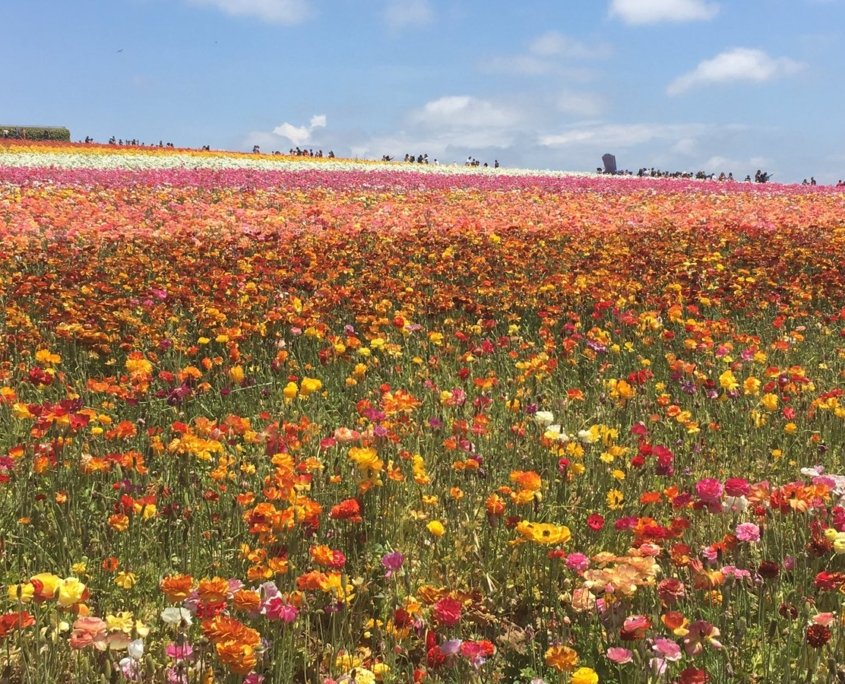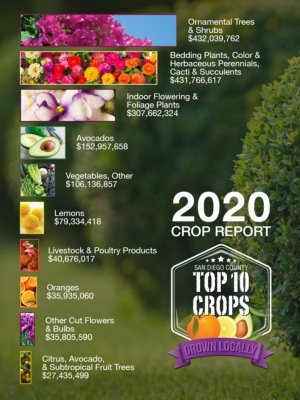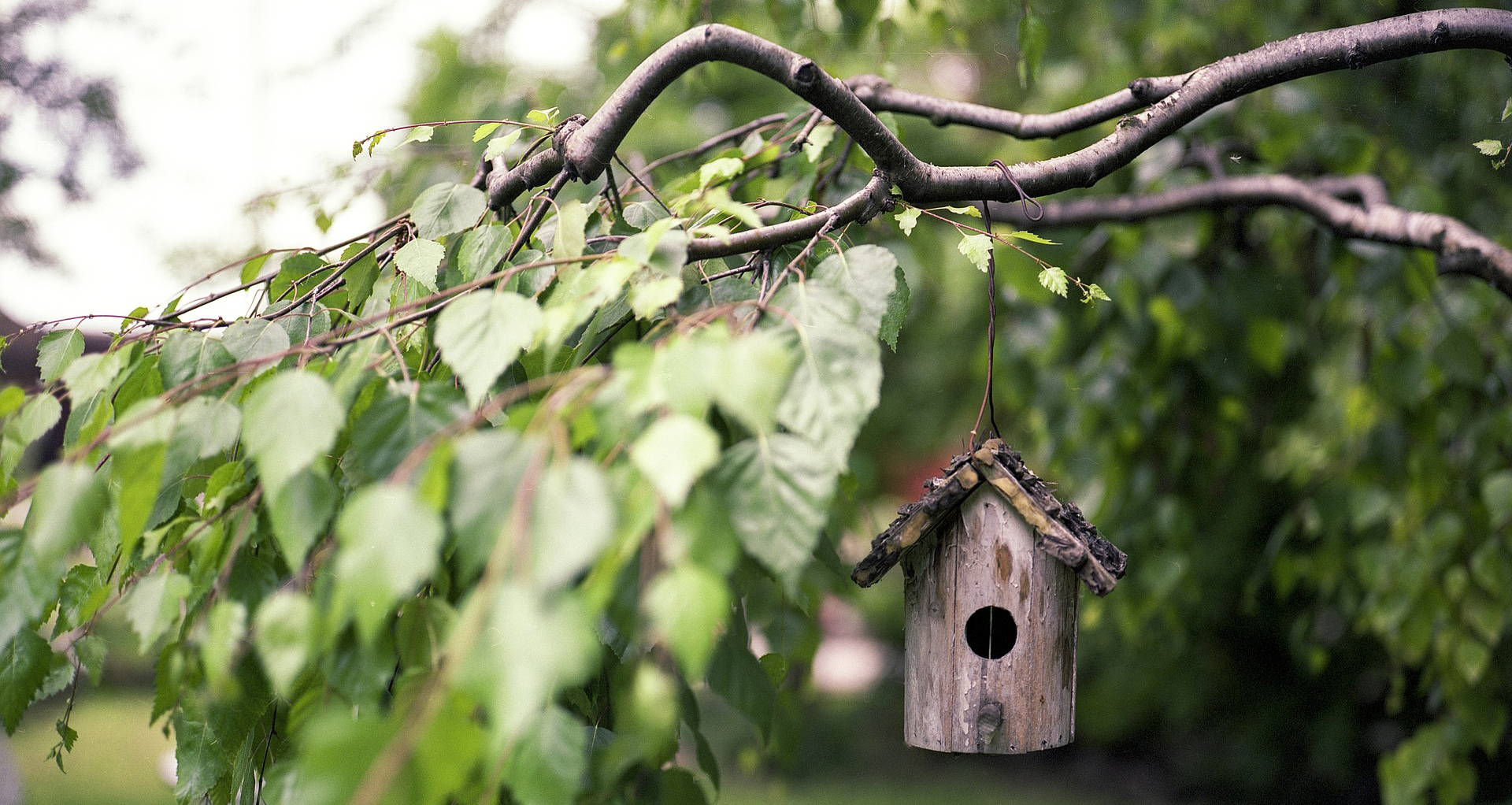How Dry are Our Lakes as Drought Continues On Central and South Coasts?
The Central and South Coasts are once again experiencing a drought. We take a look at how it’s affecting one part of our region’s water supply.
The Central and South Coasts are once again experiencing a drought. We take a look at how it’s affecting one part of our region’s water supply.
Agriculture values topped $1.8 billion for the first time since 2014 and just the third time in 30 years in the County of San Diego’s annual Crop Report that covers the 2020 growing season, overcoming decreases in many crop values and reported mixed effects of the coronavirus pandemic.
The total value of all agriculture crops and commodities rose just 0.8% in the new Crop Report. But that was enough to push total values from $1,795,528,573 in 2019 to $1,810,326,411.
It was the fourth time in the past five Crop Reports that overall agriculture values increased, and the third time since 1990 that total values topped $1.8 billion in San Diego County. Values exceeded $1.8 billion in both 2013 and 2014.
The overall increase in 2020 was boosted by gains from the two largest groups of crops grown in the county — Nursery & Cut Flower Products, which account for 70% of all crop values; and Fruit & Nut Crops, which account for 19% of all crop values.
Nursery & Cut Flower Products increased 2%, from $1.25 billion to $1.27 billion. Fruit & Nut Crops increased 0.7%, from roughly $342 million to $344 million.
A smaller agriculture group, Forest Products, which includes timber and firewood, increased 1.5% from $855,154 in 2019 to $868,398.
But the other four crop groups decreased — Vegetable & Vine Crops, Field Crops, Apiary Products and Livestock and Poultry.
The largest of those groups, Vegetable & Vine crops, which account for 7% of total agriculture values, decreased 6.3%, from roughly $131 million to $122 million. It marked the fourth decline for Vegetable & Vine crops in the past five reports.
The report stated that the effects of the coronavirus pandemic appeared to be mixed. Some growers reported labor shortages and business closures; others suggested the people staying home because of the pandemic may have increased demand for items such as bedding plants, perennials, and indoor flowering and foliage plants.

The overall increase in San Diego County 2020 agriculture values was boosted by gains from the one of the two largest groups of crops grown in the county: Nursery & Cut Flower Products, which account for 70% of all crop values. Photo: Carlsbad Flower Fields / Ed Joyce
Among the individual crops, the county’s king of the annual Top 10 list continued to be Ornamental Trees & Shrubs despite a 3% decrease in total value.
Ornamental Trees & Shrubs decreased from $445 million in 2019 to $432 million, but still edged out the number two crop, Bedding Plants, Color & Herbaceous Perennials, Cacti & Succulents, at $431.8 million.
San Diego County’s most well-known crop, Avocados, remained in fourth place on the Top 10 list, increasing in value in 2020 by 9.2%, from nearly $140 million to nearly $153 million, after increasing nearly 16% in 2019.
The rest of the Top 10 crops remained relatively similar to past years. Oranges and Livestock and Poultry exchanged places, with Oranges falling from the seventh spot to eight, and Livestock and Poultry rising from eight to seven.
The annual Crop Report is compiled by the County’s Department of Agriculture, Weights and Measures and can be seen online. The report provides a yearly snapshot of an industry that remains a staple of the region’s economy despite challenges like drought, rising water costs, fires, freezes, pests and the pandemic.
San Diego County’s Board of Supervisors has taken several actions over the years to boost agriculture, including creating a boutique winery ordinance to promote the creation of small wineries; approving a beekeeping ordinance that allows more beekeeping while protecting the public; adopting an agricultural easement program that preserves agricultural space; and streamlining regulations for things like cheese-making, agritourism and onsite horticultural sales.
Last year, the Board unanimously voted to help growers by deferring fees for export certification, direct marketing, and hazardous materials inventory, allowing growers use those funds for operation needs during the pandemic.
Supervisor Jim Desmond represents the County’s Fifth supervisorial district, which is home to a lot of the county’s agricultural land.
“During the pandemic, we have seen how essential farming is in San Diego County,” Desmond said. “Despite a difficult past 16 months for everyone, it’s great to see farming thriving. It is an honor to be the supervisor of District Five, which has a diverse variety of agricultural crops ranging from flowers to strawberries and avocados!”

(Editors note: This story by
A harvester rumbles through the fields in the early morning light, mowing down rows of corn and chopping up ears, husks and stalks into mulch for feed at a local dairy.
The cows won’t get their salad next year, at least not from this farm. There won’t be enough water to plant the corn crop.
Climate change, drought and high demand are expected to force the first-ever mandatory cuts to a water supply that 40 million people across the American West depend on — the Colorado River. The U.S. Bureau of Reclamation’s projection next week will spare cities and tribes but hit Arizona farmers hard.
Officials in Lower Colorado River Basin states want to slow the decline of Lake Mead’s water levels over the next few years by paying Southern California farmers not to plant crops.
Beginning this past Monday, Roseville residents are required to reduce water use by 20 percent.
The mandatory conservation requirement builds upon the 10-percent voluntary water use reduction announced in May and recognizes that the water supply outlook is stressed at Folsom Lake and throughout California.
Federal authorities are expected to declare a water shortage for Lake Mead Monday, which would trim Nevada’s allocation of water in 2022.
A shortage gets triggered if the lake is expected to sit below 1,075 feet on January 1, 2022. As of Wednesday morning, the lake sits at 1,067.93 feet. The shortage has been anticipated as Lake Mead’s water level continues to drop.
Tehama County Farm Bureau acknowledges the hard work of its members and their ability to feed the world during these difficult times.
“This past year has been a challenge for our local farmers and ranchers as the pandemic created a more difficult trading relationship resulting in lower prices for commodities,” said President Shelley Macdonald. “Add the drought and the export of surface water and it’s been a tough year for them.”
Tehama County agriculture leads the local economy by contributing $300,826,400 in total crop value in 2019.
Looking to bolster its water reserves during a historic drought, the Palmdale Water District, on Monday, continued its request that customers conserve water by 15% and also agreed to purchase water from another State Water Project contractor.
The Board of Directors reaffirmed the voluntary water conservation program by implementing Stage Two of its Water Shortage Contingency Plan.
The District, in June, adopted an updated Water Shortage Contingency Plan, in which the requested 15% reduction falls under Stage Two instead of Stage One, as it was in the previous plan.
New waterwise landscaping represents a significant investment in time and cost. Trees stand out as the most valuable players in your landscape design. No other landscape plant offers greater benefits to your landscape and the environment as a whole.
Trees save energy and clean the air. They counteract the urban heat island effect and fight climate change. Trees provide property protection and improve property values. Neighbors with more trees even have lower crime rates.
Investing in tree maintenance is vital to keep them healthy. Tree pruning should only be done for a specific reason. First, for corrective or preventative measures. Second, to remove dead, crowded, or poorly angled branches or to reduce potential hazards. Third, to increase light and air penetration for healthy growth.

Trees are the most valuable players in your landscape design, and you can keep them healthy by using proper pruning techniques. Photo: Benjamin Balazs/Pixabay
Routine thinning does not always improve the health of a tree. Removing large amounts of foliage all at once can put stress on a tree’s stored energy reserves, resulting in stunted growth.
Pruning should be performed in the best season for the tree to avoid potential disease and to avoid pruning just after the spring growth flush.
There should be a purpose for each cut, as each cut into a tree can change the growth of the tree for many years to come. Improper or careless pruning can cause damage over the life of the tree. It is important to know where and how to make cuts before beginning the process.
When a tree branch is cut, it compartmentalizes the wound to protect itself. A small cut does less damage than a large cut. Waiting to prune a tree until it is mature can create the need for large cuts, which can threaten the life of the entire tree. Ongoing and regular maintenance is a must.
Call on a certified arborist to maintain your trees in optimal health. Arborists are specialists trained in the art and science of planting, caring for, and maintaining individual trees. They can identify and treat diseases before they spread to other trees. Find qualified professionals at the International Society of Aboriculture and the American Society of Consulting Arborists.
This article is part of a year-long series inspired by the 71-page Sustainable Landscapes Program guidebook. The Water Authority and its partners also offer other great resources for landscaping upgrades, including free WaterSmart classes at WaterSmartSD.org.